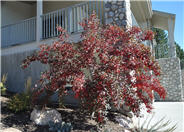
Common name:Purpleleaf Sandcherry
Botanical name:Prunus x cistena
Purpleleaf sandcherry is a deciduous shrub valued for its reddish-purple foliage, fragrant white and pink spring flowers, and purple-black fruit. It grows about 7 to 10 feet tall and 5 to 8 feet wide, with an upright, vase shape. It is sometimes sold as a single-stem tree, but will require maintenance to maintain this form. Bark is a dark brown to red, and is a nice contrast in the winter garden. Branches are nice in vases.
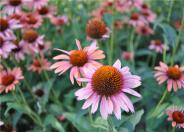
Common name:Purple Coneflower
Botanical name:Echinacea purpurea
The Purple Coneflower is a long-lived, reliable standby for the perennial garden. And while not xeric, it manages quite well with just weekly watering. Rosy purple petals fall below the prominent orange-tinged cone and blooms in late June to September. Foliage is large, with a rounded lance shape. An excellent cut flower, they provide nectar for bumblebees and butterflies, and the seeds provide forage for migrating song birds, so don't cut them all!
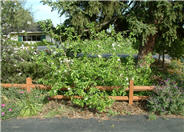
Common name:Apple, edible
Botanical name:Malus
Apples can be a wonderful addition to an edible landscape. Typically, they are available as in dwarf,semi-dwarf and standard sizes, though not all varieties are available in each size. Consider the space available before you select a variety and size.
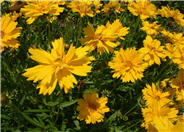
Common name:Double Sunburst Coreopsis
Botanical name:Coreopsis grandiflora 'Double Sunburst'
'Double Sunburst' Coreeopsis has showy, double to semi-double, daisy-like flowers with yellow rays and darker yellow center disks atop long, slender stems. Blooms from June to August. Leaves are lance-like, green, and mostly basal. It makes for good cut flowers, and cutting the flowers off helps to keep the plants abundant with blooms. Grows 18 to 24" tall and 12 to 18" wide.
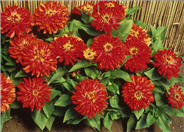
Common name:Zinnia
Botanical name:Zinnia elegans
Like marigolds, there may be too many zinnia to mention in this tiny space. These annuals come in a range of sizes and a wealth of colors from the softest of salmons and apricots to traffic stopping reds and oranges. Flowers have single, double, or frilled petals; foliage is green. Attractive to bees, butterflies, and birds. An excellent cut flower.
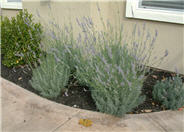
Common name:Provence French Lavender
Botanical name:Lavandula x intermedia 'Provence'
Provence is one of the lavenders grown commercially in France. 30 to 36 inches tall and 24 to 30 inches wide, it produces long stems of pale lavender flowers prized for their fragrance and flavor. Gray-green foliage is also pleasantly aromatic. Grows in full sun and well drained soil. This lavender gets big, so plant it where it will have the space it needs. It is also woodier than other lavender.
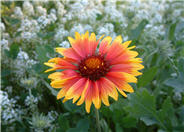
Common name:Blanket Flower
Botanical name:Gaillardia x grandiflora
Blanket flowers are a long-time favorite for hot, dry perennial gardens and meadows. The flowers are daisy-like, with an ombre-like color arrangement from yellow to orange to maroon, though many modern cultivars are single-colored. Eyes range from brown, to maroon, to yellow, depending on the cultivar. Leaves are green to grey green, and either oval to oblong, slightly toothed to deeply lobed. Size varies with cultivars, between 12 to 36 inches tall and 18 to 30 inches wide. Companions well with salvia, agastache, and lavender.
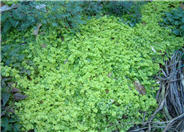
Common name:Creeping Jenny, Moneywort
Botanical name:Lysimachia nummularia
Creeping Jenny is a trailing groundcover that grows in most situations, but prefers shade and moderate moisture. Its yellow fragrant flowers have 5 rounded petals nestled in the round leaf pairs in May and June. It forms dense mats that can become invasive, but is well suited as a ground cover with larger, woody shrubs. Is attractive in rock walls and cascading out of pots. There are cultivars available, ones with yellow to chartreuse foliage.
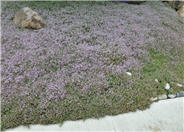
Common name:Reiter Creeping Thyme
Botanical name:Thymus 'Victor Reiter'
Reiter thyme is a tough, vigorous groundcover. Forms dense mats that can tolerate foot traffic and choke out most weeds. It grows to 3 inches tall and spreads 30 inches. Rich, olive green foliage is topped with lavender flowers in mid-summer. Faded flowers can be removed using a lawn mower. It has a pleasant, minty fragrance when crushed, though not considered for culinary uses. Attracts bees and butterflies.
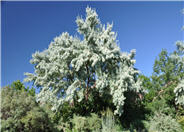
Common name:Skyline Honeylocust
Botanical name:Gleditsia triacanthos inermls 'Skyline'
Skyline honeylocust is a tall, upright, broad, deciduous shade tree growing about 45 feet tall and 35 feet wide. It has small, pinnately compounded green leaves that turn yellow in the fall. It is a thornless and seedless variety.
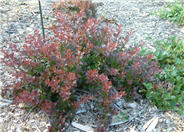
Common name:Crimson Pygmy Japanese Barberry
Botanical name:Berberis thunbergii 'Crimson Pygmy'
Crimson Pygmy Barberry is a deciduous shrub with arching branches and a dense, mounding habit. New foliage is bright red, turning to a bronzy red to deep green in summer. Autumn color is bright red. Prefers full sun and regular watering; color is less red in shade. Thorns make this shrub well suited as a barrier hedge, though it is of small enough scale to be valuable in a mixed perennial/shrub border.
| Designer: The Urban Garden Inc. | Urban Garden 15 |
Photographer: GardenSoft |
Water Saving Tip:
Even though it's hot, your lawn only needs to be watered twice a week to stay healthy.
And don't water the whole lawn for a brown spot—drag out a hose.
